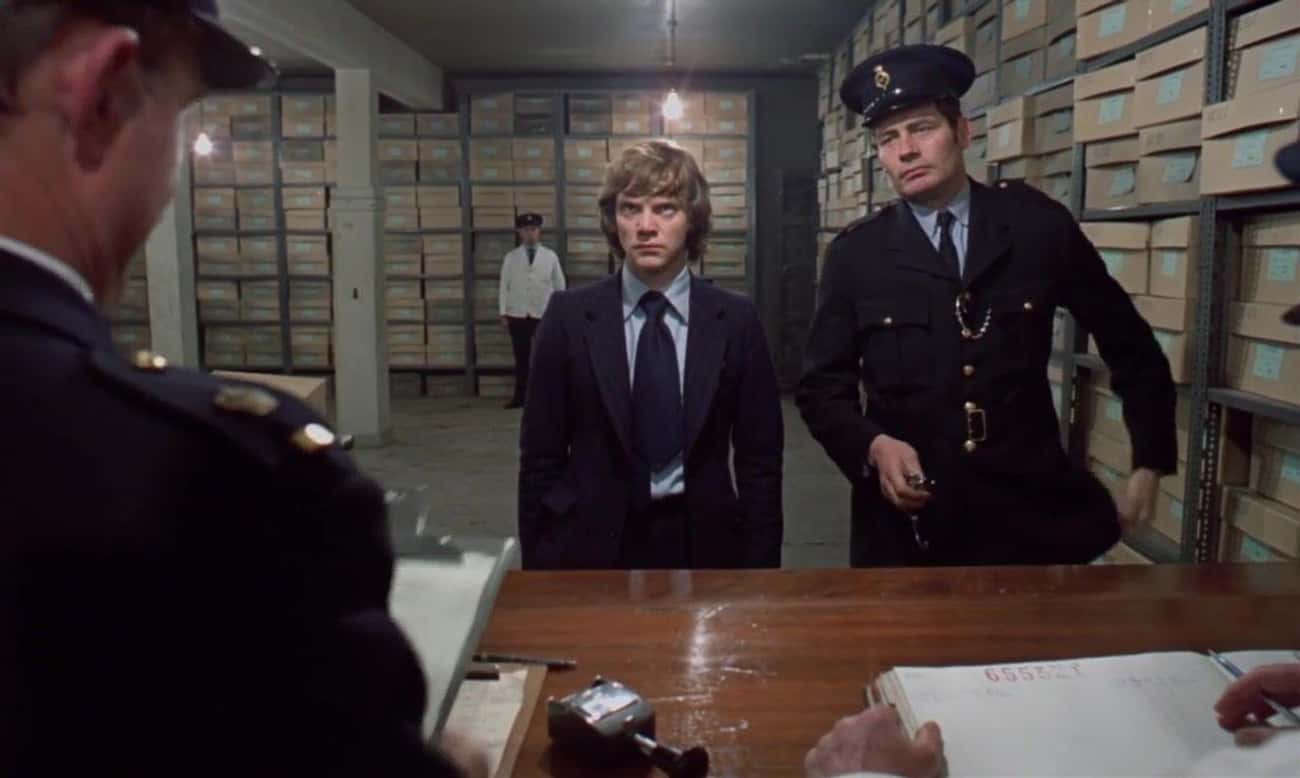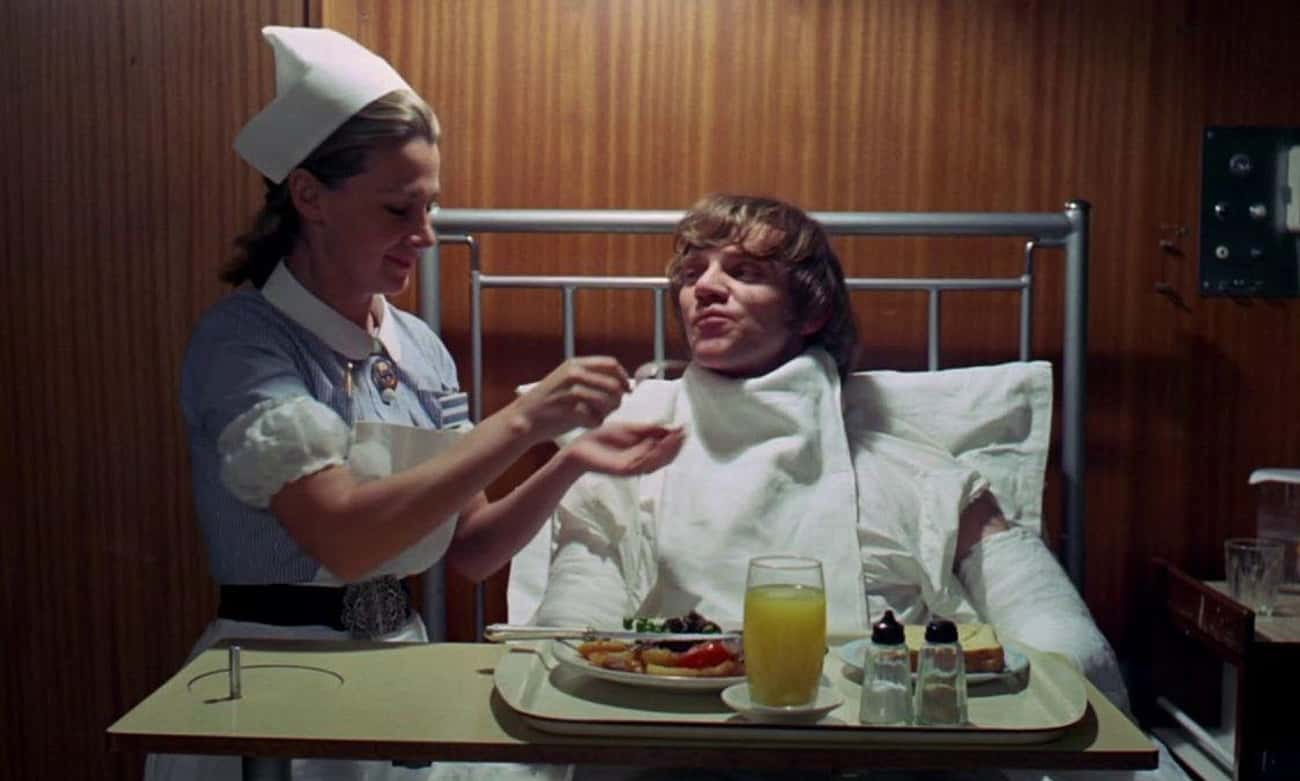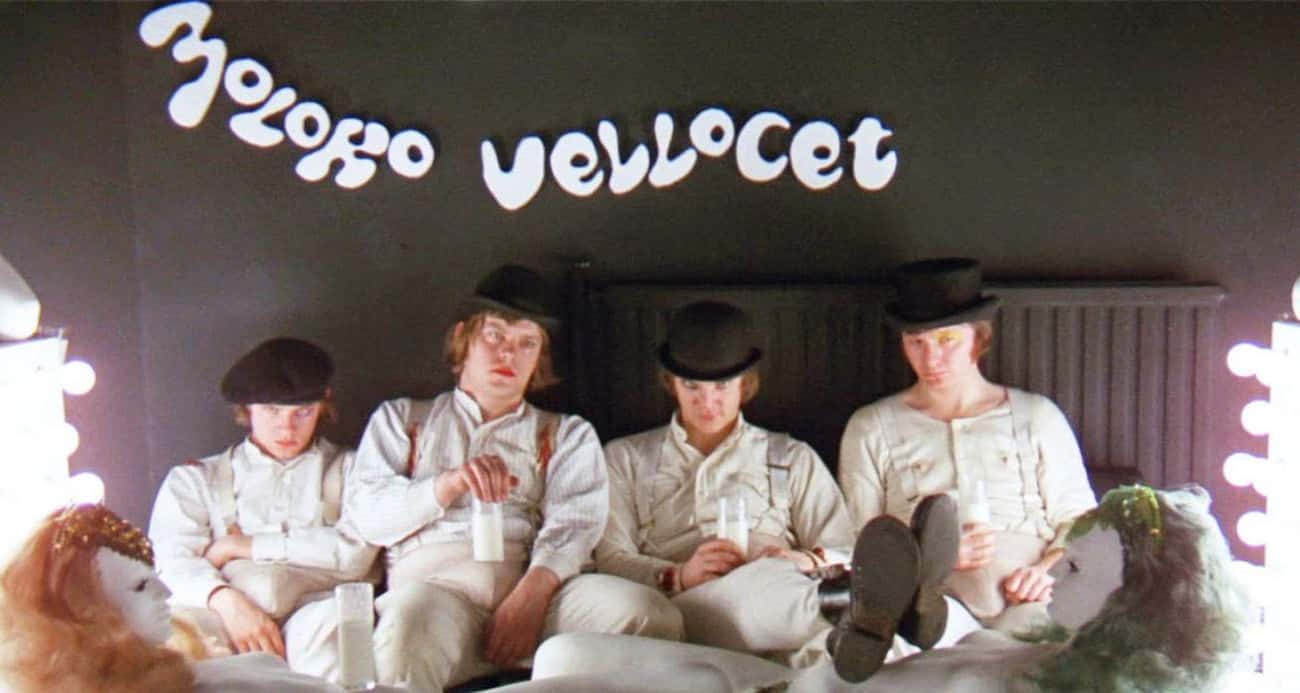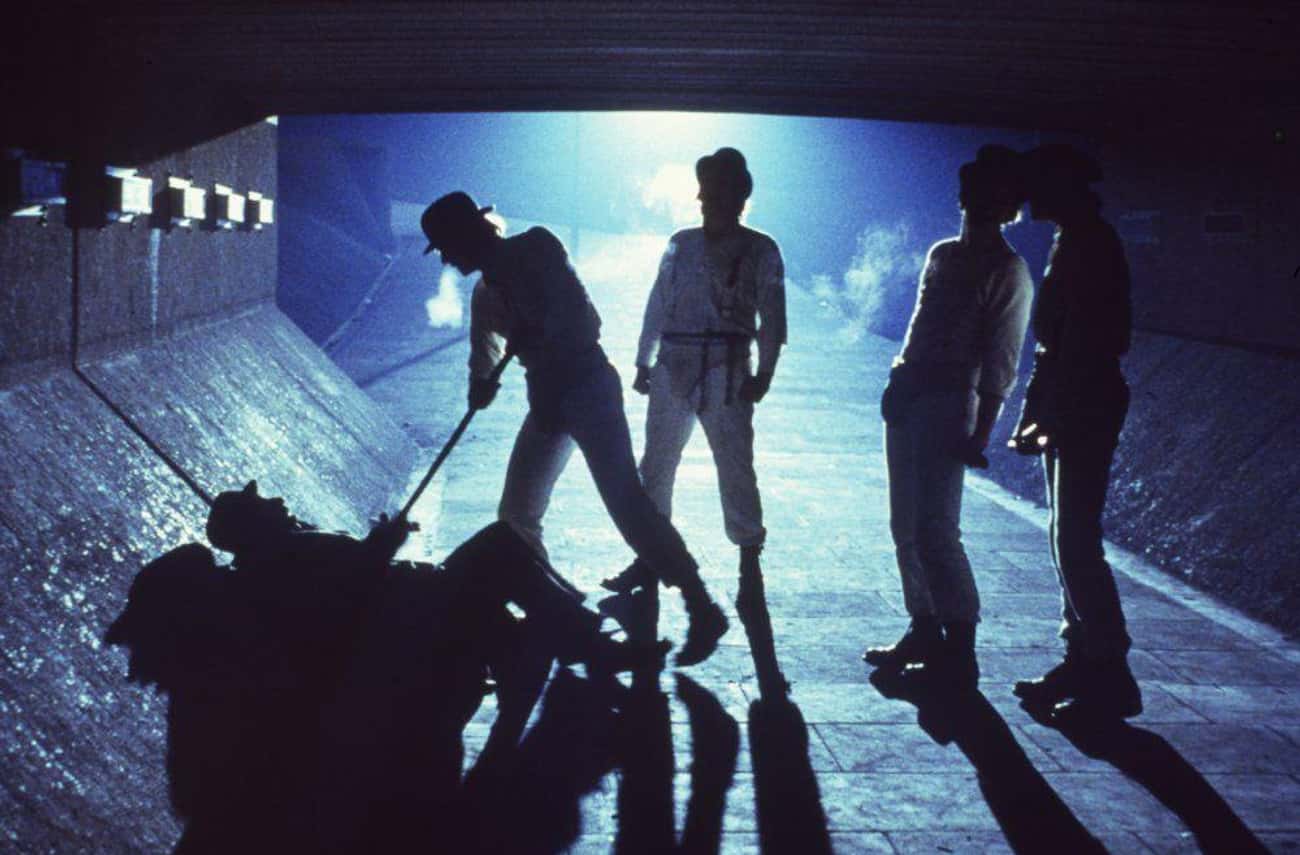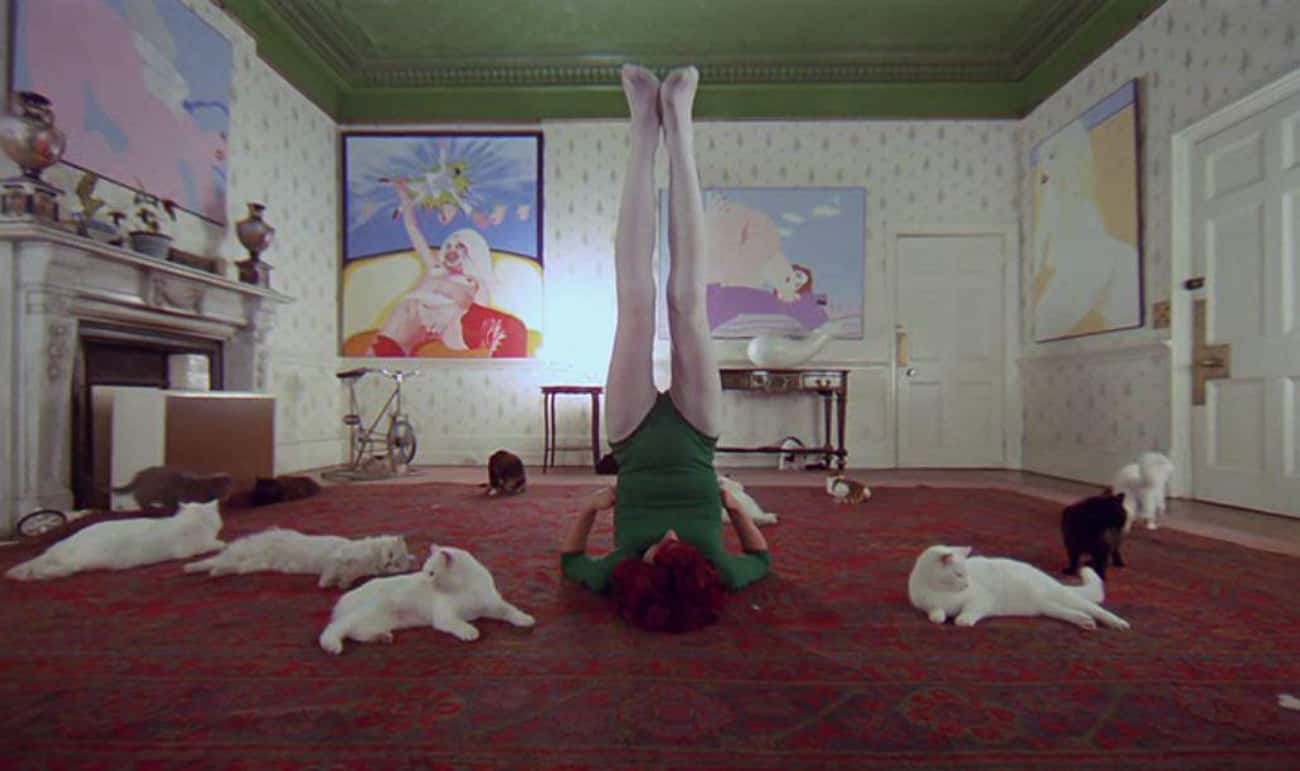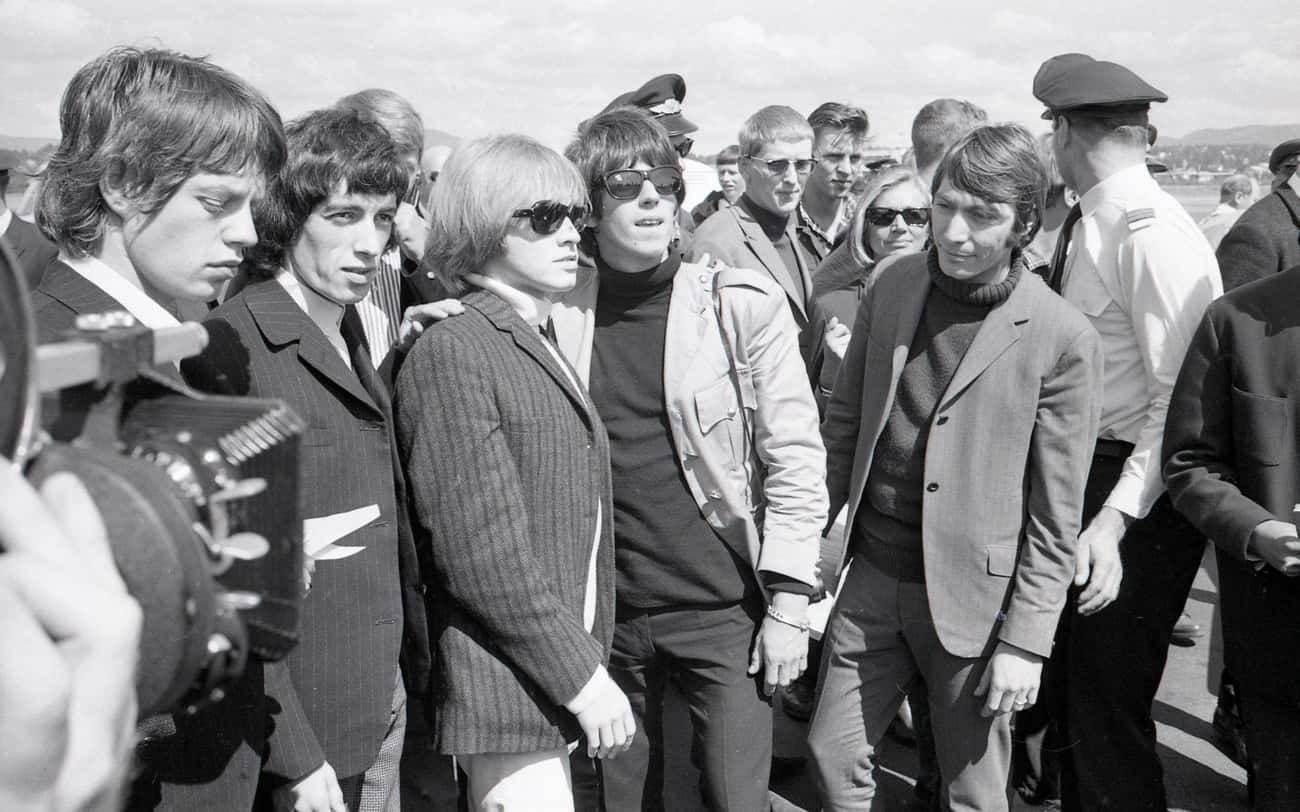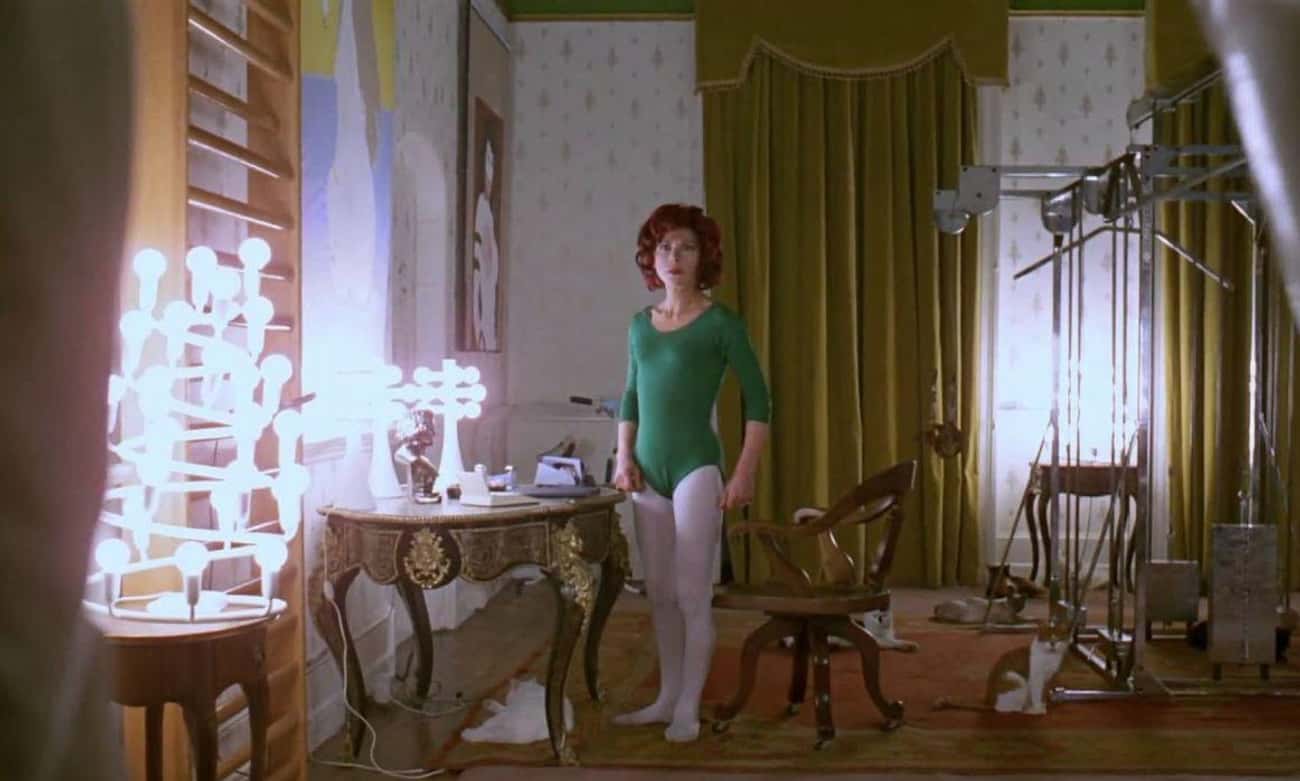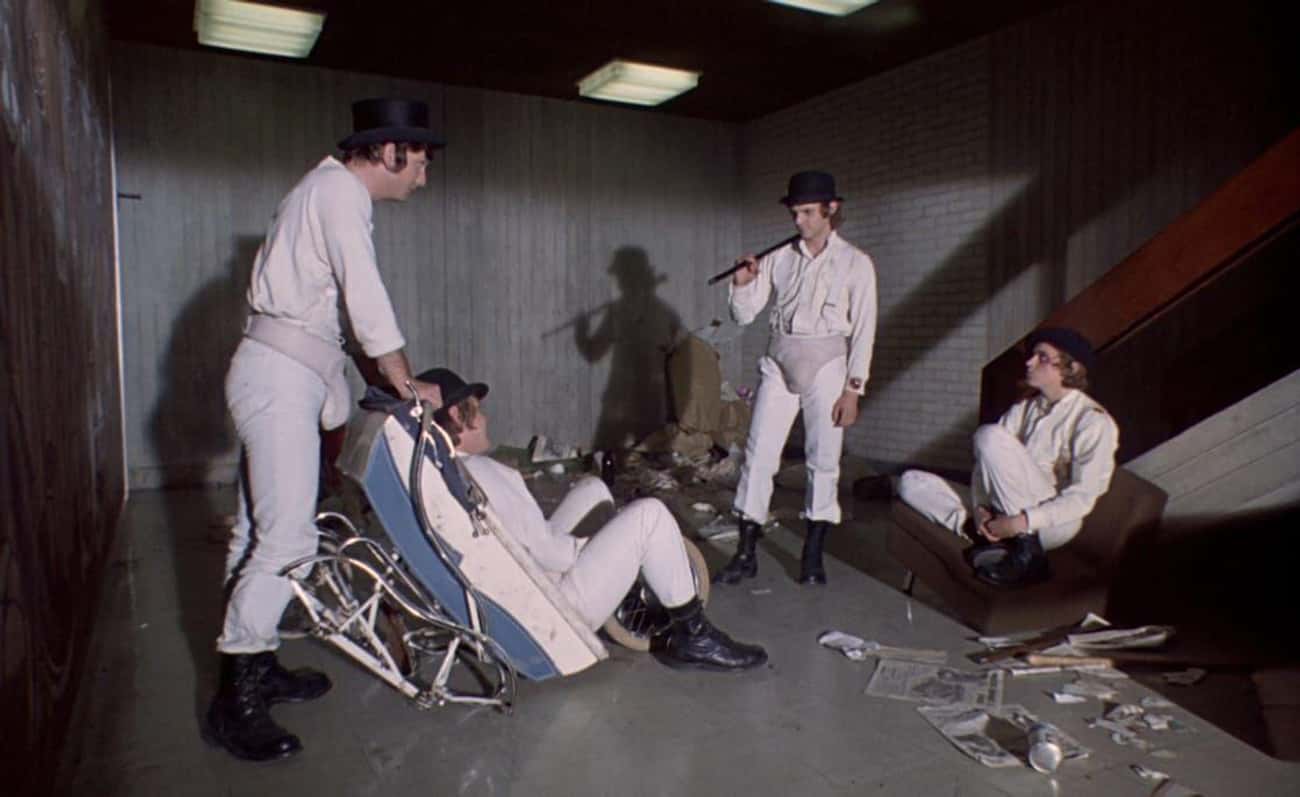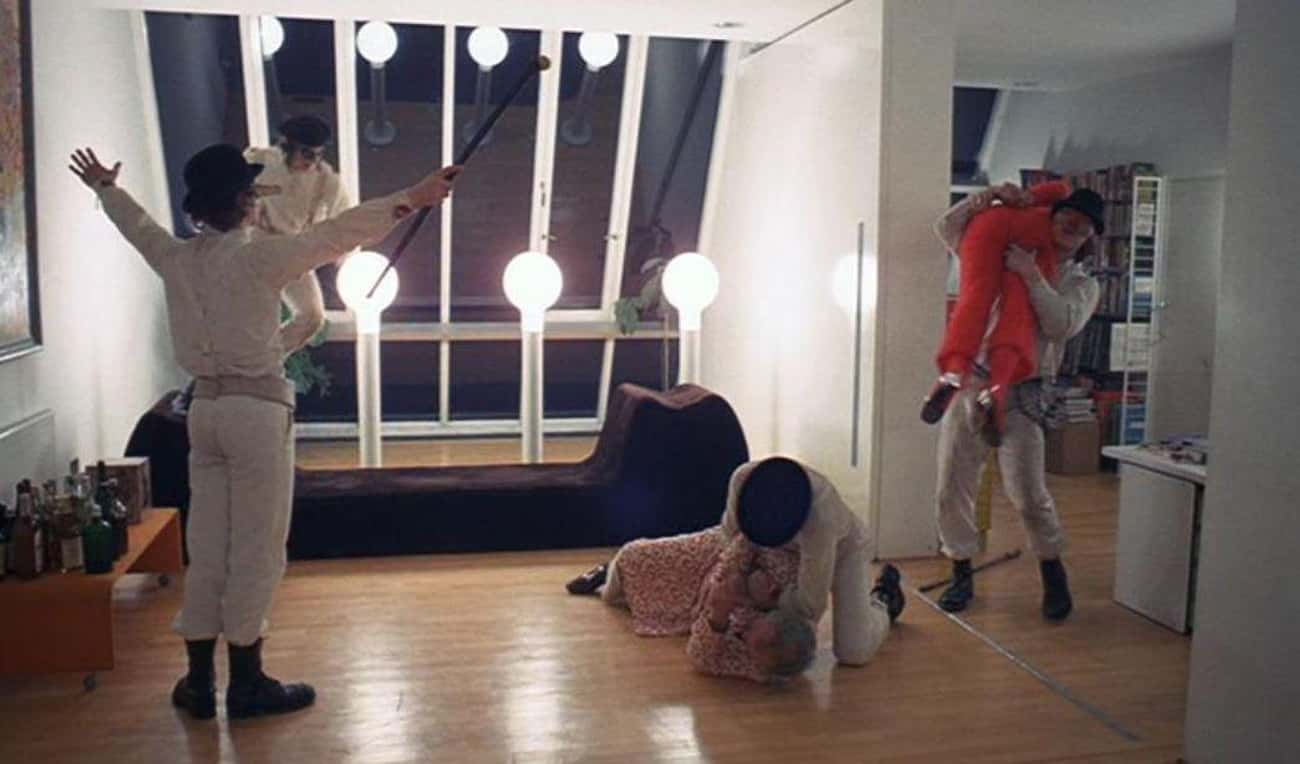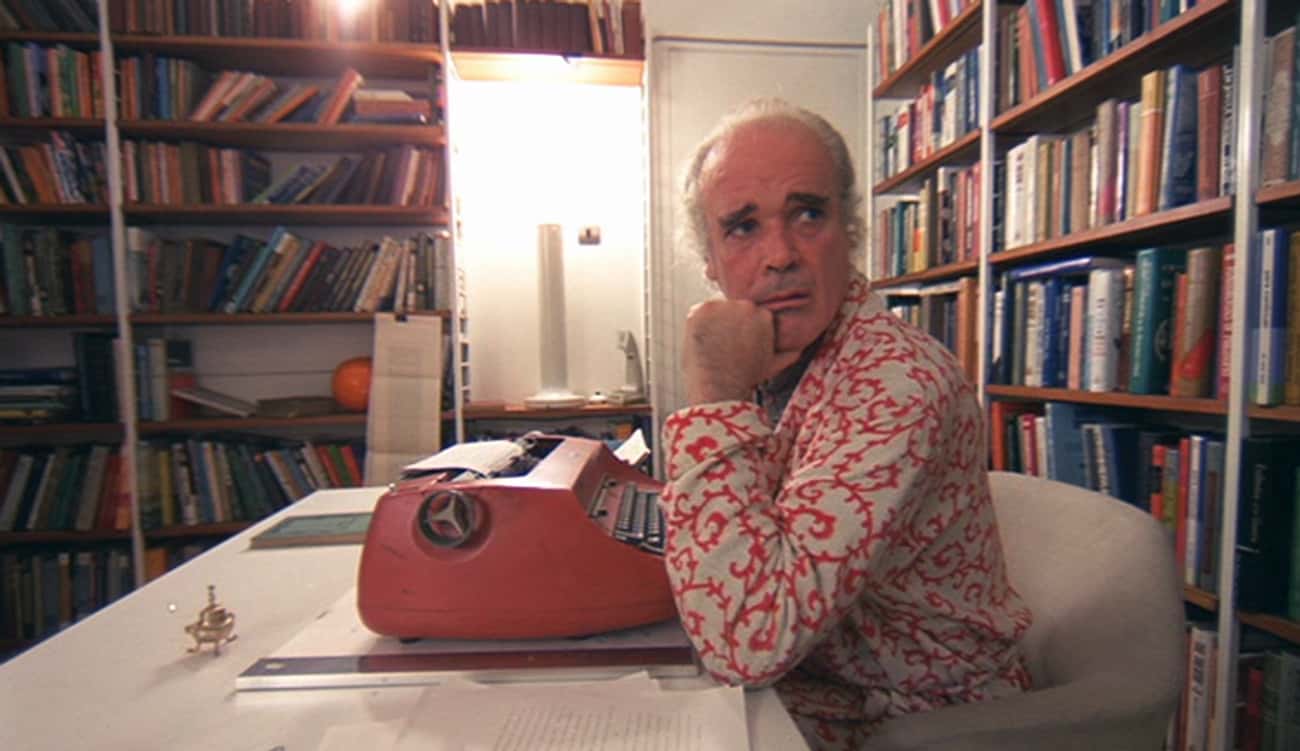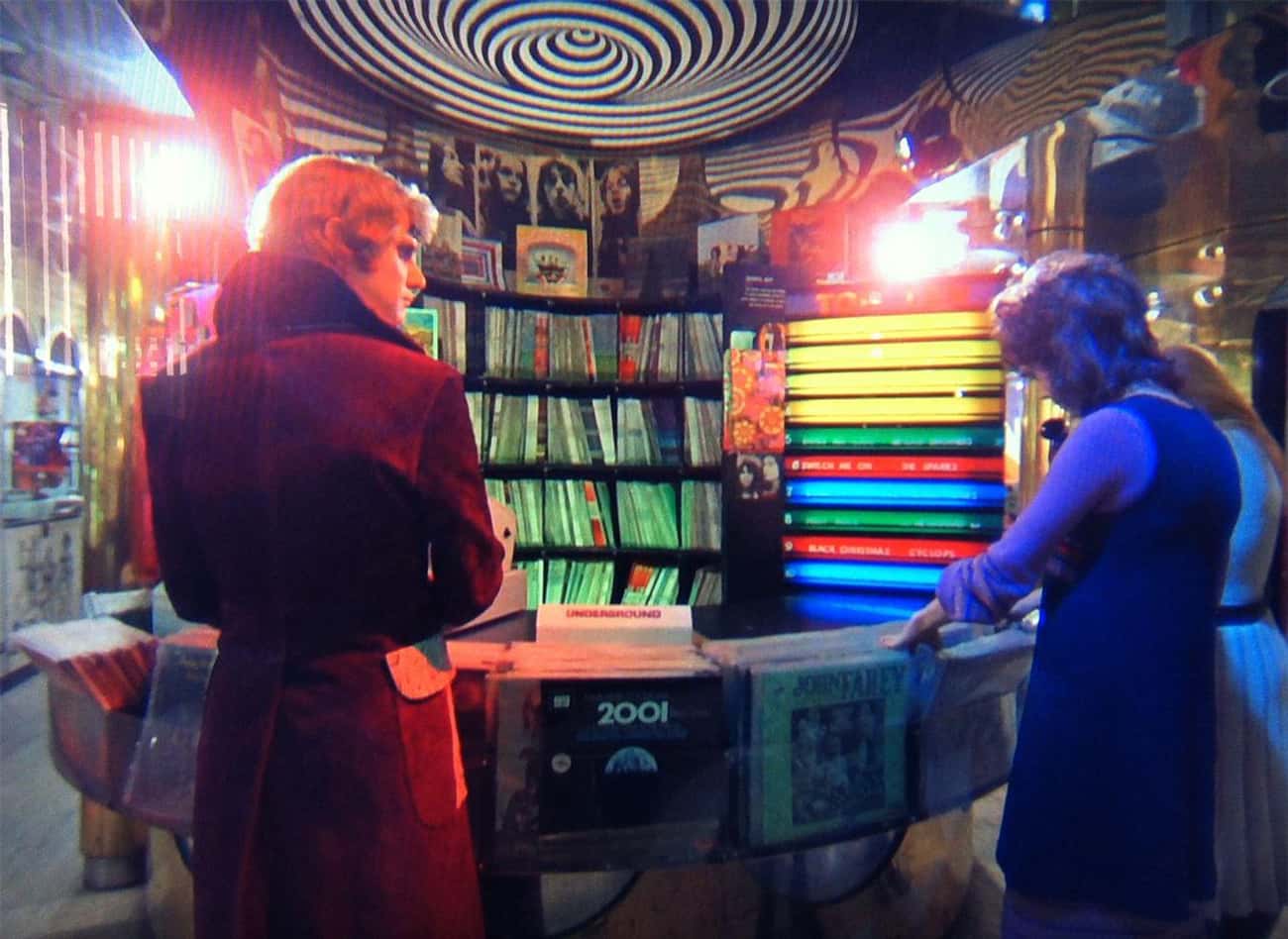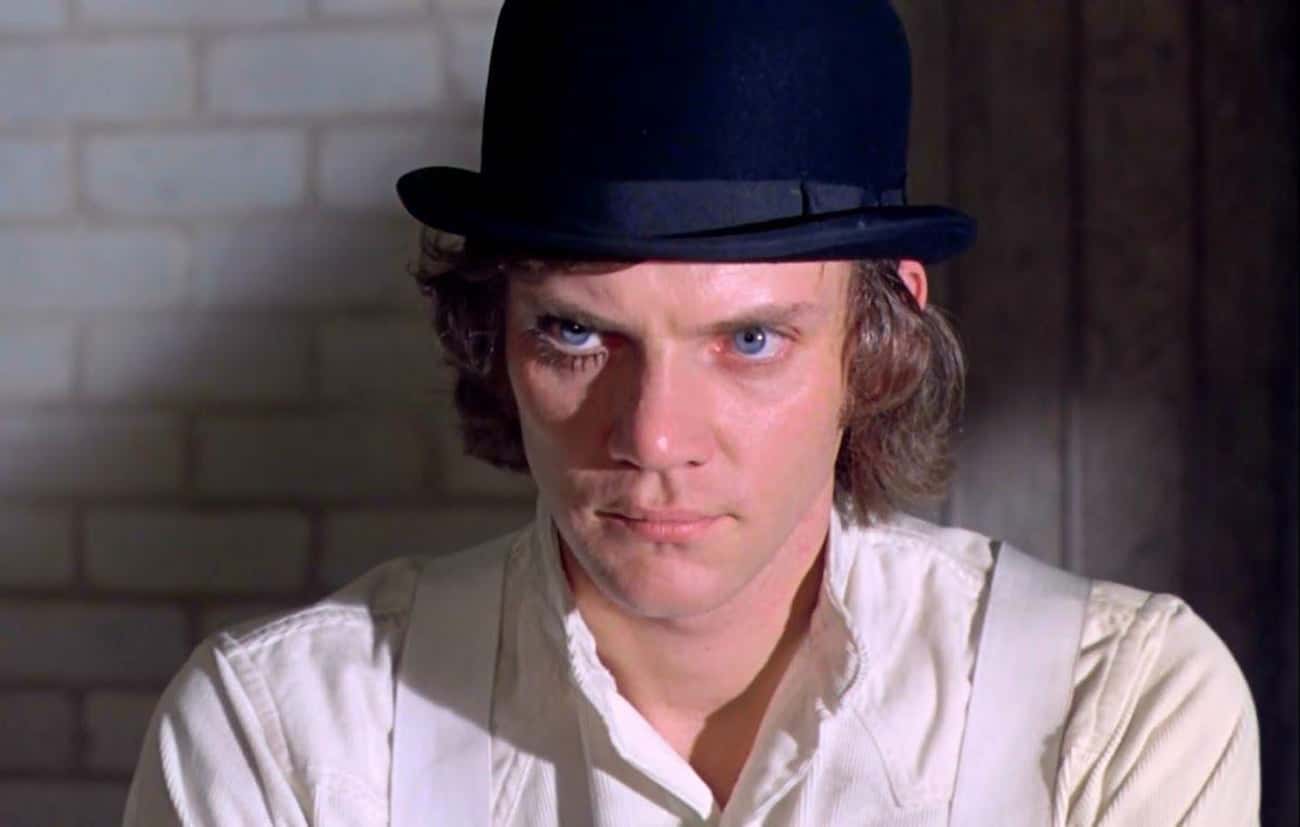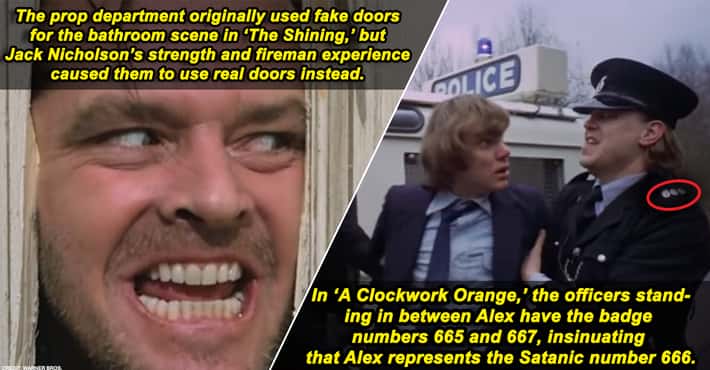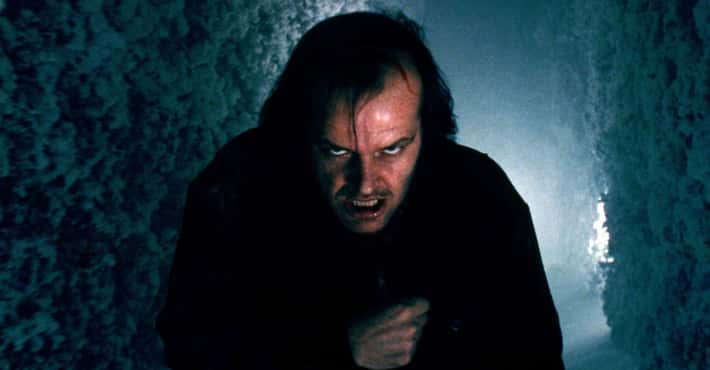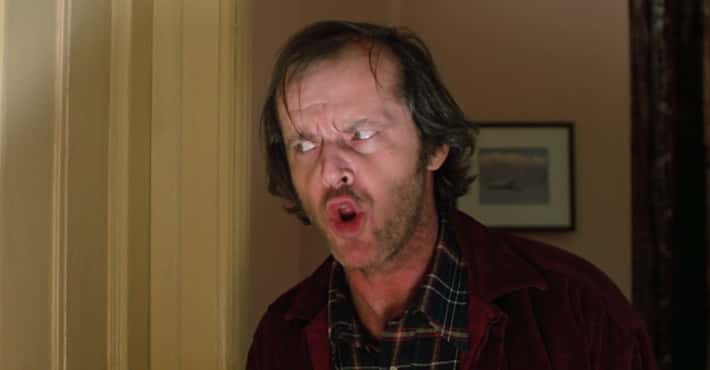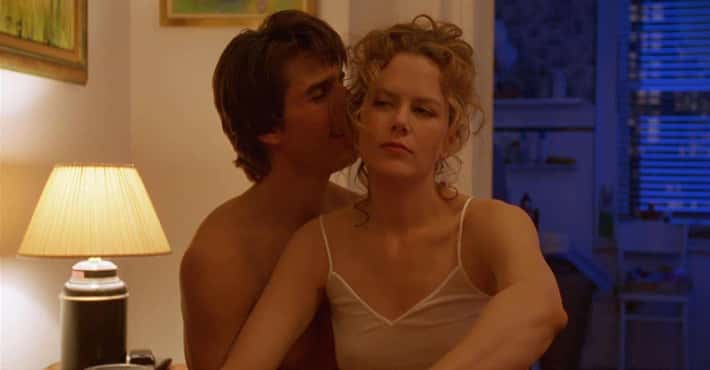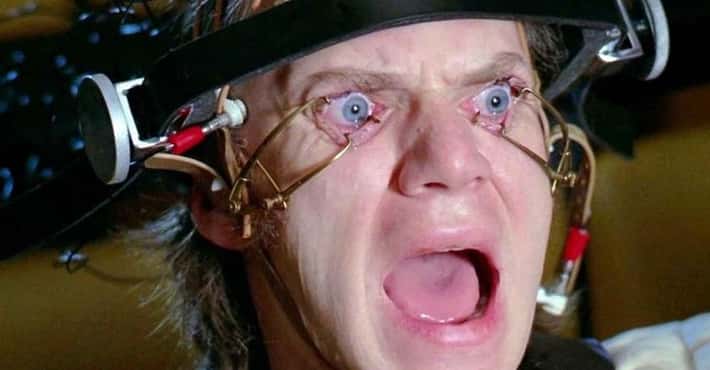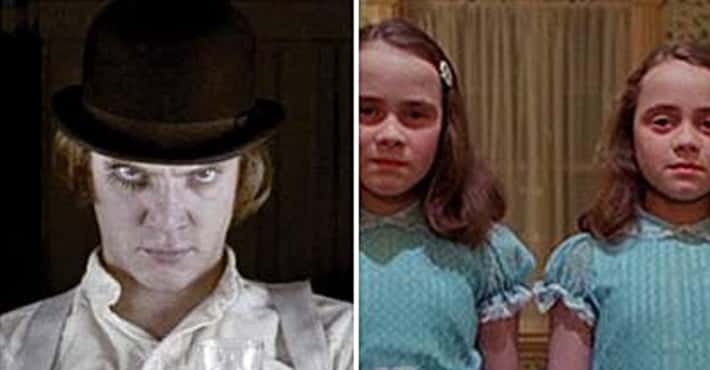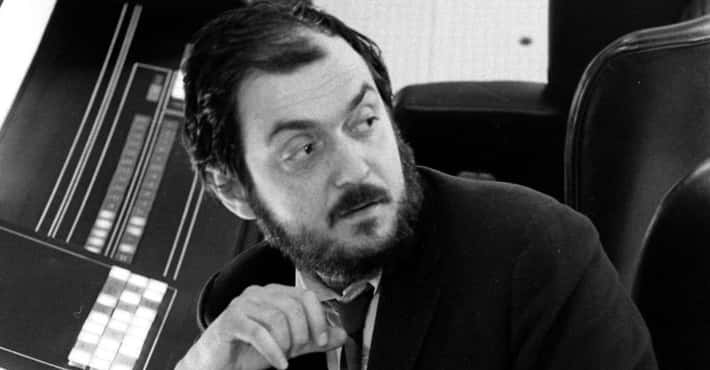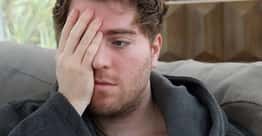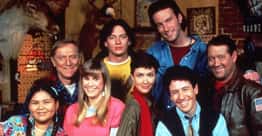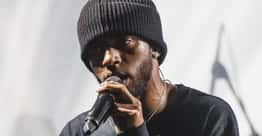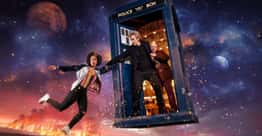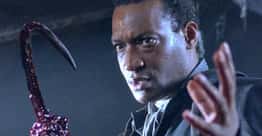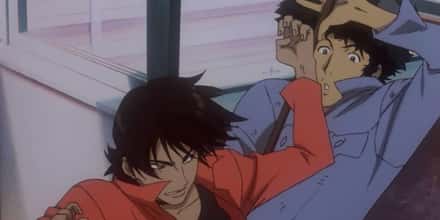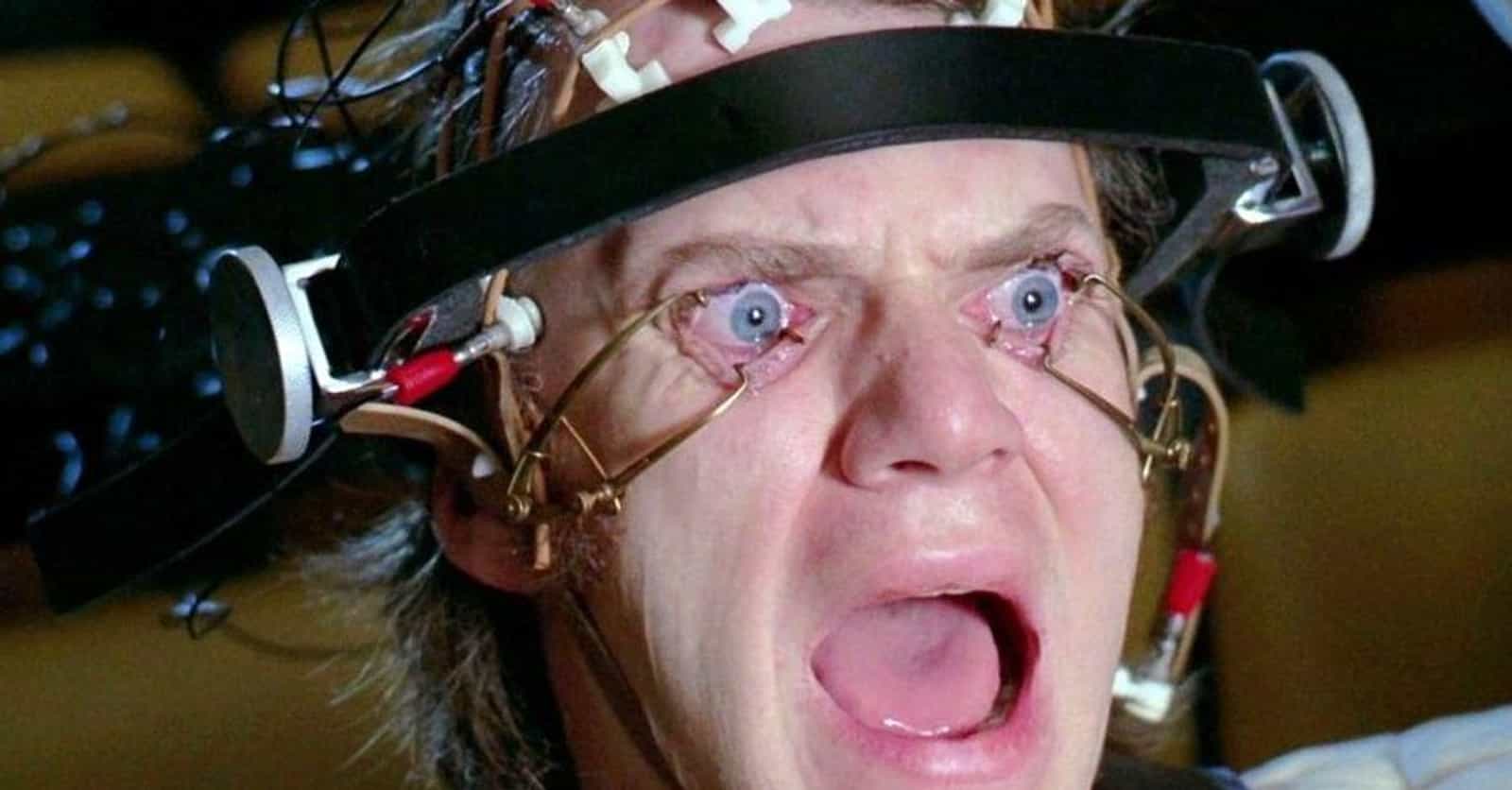
Kubrick And Codpieces: Behind The Scenes Of 'A Clockwork Orange'
Vote up the most intriguing stories from the making of Kubrick's controversial dystopian classic.
- 10 VOTES
The Movie’s Iconography Was Blamed For A Series Of Youth Crimes, Prompting Kubrick To Pull It From Circulation
Photo: Warner Bros.Following A Clockwork Orange's release, several copycat offenders popped up around London. One of the most notorious incidents occurred when a group of young men from Lancashire physically attacked a 17-year-old girl. The men sang "Singin' in the Rain" the whole time.
A 16-year-old young man slayed an elderly homeless man, and when he was found guilty, he said he did it after hearing about a similar scene in A Clockwork Orange. There was also an incident where a 16-year-old teen dressed up like Alex and his Droogs and attacked another teenager.
Following the copycats, Kubrick argued art has a long history of cruelty. He contended his film cannot be held responsible for the behavior of others:
No one is corrupted watching A Clockwork Orange any more than they are by watching Richard III... The film has been accepted as a work of art, and no work of art has ever done social harm, though a great deal of social harm has been done by those who have sought to protect society against works of art which they regarded as dangerous.
... Many psychiatrists believe [offensive art] serves as a catharsis rather than a model... I know there are well-intentioned people who sincerely believe that films and TV contribute to [illicit activity], but almost all of the official studies of this question have concluded that there is no evidence to support this view. At the same time, I think the media tends to exploit the issue because it allows them to display and discuss the so-called harmful things from a lofty position of moral superiority.
But the people who commit [salacious acts] are not ordinary people who are transformed into thugs by the wrong diet of films or TV. Rather, it is a fact that [these crimes are] invariably committed by people with a long record of antisocial behavior, or by the unexpected blossoming of a psychopath who is described afterward as having been "...such a nice, quiet boy," but whose entire life, it is later realized, has been leading him inexorably to the terrible moment, and who would have found the final ostensible reason for his action if not in one thing then in another. In both instances immensely complicated social, economic and psychological forces are involved in the individual's behavior.
The director eventually removed his controversial movie from distribution in the UK. Besides having to deal with the publicity and horror of the copycat offenders, Kubrick and his family had also received threats. The film remained out of distribution until Kubrick passed in 1999.
- 20 VOTES
There Was No Way That Kubrick Was Going To Give The Movie A Happy Ending Like In The Novel
Photo: Warner Bros.As far as film adaptations go, Kubrick's A Clockwork Orange is more or less faithful to Burgess's novel. The ending, however, deviates from the source material. In the film, Alex winds up with a government job after recovering from an attempt on his life. It's made clear that he has not been fully rehabilitated, though he now works in a position of power.
In the novel, after Alex leaves the hospital, he finds a new group of Droogs. He once again pursues his offensive ways, even though he no longer finds joy in his actions. When he runs into one of his former Droogs, who is living as a model citizen, Alex becomes intrigued. The books ends with the notion that the former juvenile delinquent may in fact be ready to take on a normal existence.
Turns out Kubrick was trying to remain faithful to the source material with his ending, he just wasn't aware the American version of Burgess's novel is different than the English version. In the American version, the final chapter featuring a happy ending for Alex and British society is left out. Even if Kubrick had read the original, however, he said he would have still avoided a happy ending. Kubrick explained:
There are two different versions of the novel. One has an extra chapter. I had not read this version until I had virtually finished the screenplay. This extra chapter depicts the rehabilitation of Alex. But it is, as far as I am concerned, unconvincing and inconsistent with the style and intent of the book. I wouldn't be surprised to learn that the publisher had somehow prevailed upon Burgess to tack on the extra chapter against his better judgment, so the book would end on a more positive note. I certainly never gave any serious consideration to using it.
- 30 VOTES
For The Korova Milk Bar, A Bare Model Was Photographed In As Many Table-Like Positions As Possible
Photo: Warner Bros.The Korova Milk Bar is one of four sets built specifically for A Clockwork Orange because Kubrick wanted it to look futuristic. The rest of the movie is shot on location. The Korova Milk Bar is exactly what it sounds like; a bar that serves milk spiked with different kinds of hallucinogens and other mind-altering substances, and because it is a "milk" bar, minors are allowed to drink there.
The interior of the Korova is filled with furniture shaped like bare women. Kubrick said they had a real model pose in various positions to create the look of the bar's tables. He explained:
I had seen an exhibition of sculpture which displayed female figures as furniture. From this came the idea for the fiberglass nude figures which were used as tables in the Milk Bar. The late John Barry, who was the film's Production Designer, designed the set. To get the poses right for the sculptress who modeled the figures, John photographed a model in as many positions as he could imagine would make a table. There are fewer positions than you might think.
- 40 VOTES
Kubrick Filmed Mostly On Location Because Of Budget Restraints
Photo: Warner Bros.A Clockwork Orange is set in a dystopian future in London. At the beginning of the movie, Alex and his Droogs wreak havoc in the actual public streets of London. Kubrick was handed a $2 million budget for his film, an amount which limited his visual interpretation and forced financial creativity. When he started filming, Kubrick was coming off of 2001: A Space Odyssey, which ballooned to nearly twice the budget and took a year longer than he planned. To avoid a repeat project, A Clockwork Orange was filmed on location with the only exceptions being the four sets built by the production crew inside of a rented factory.
The locations used in the film needed to reflect the look and feel of a futuristic, dystopian city. Kubrick and the location team found inspiration by looking through issues of British architectural magazines. Alex's apartment, in particular, needed to have an extra seedy feel and was filmed in South London at the Thamesmead Housing Estate, which was a housing project. The record store scene was shot at the Chelsea Drugstore. A few other locations, all in London, were within a short distance of Kubrick's home, including the Wandsworth Bridge and the Canterbury House.
- 50 VOTES
The Infamous Phallic Statue Is Called 'The Rocking Machine,' And It Was Hand-Picked By Kubrick, Like Most Of The Shocking Props
Photo: Warner Bros.When it comes to set design, Stanley Kubrick is as meticulous and creative as any director in cinema. He will stop at nothing to make sure his vision is translated properly. He reportedly spent nearly one year in the preproduction phase of A Clockwork Orange, trying to find the perfect props, furniture, architecture, hairstyles, and locations.
Kubrick wanted to create a futuristic look in A Clockwork Orange but with the goal of making it appear that his dystopian future wasn't too far off. The director hired veteran production designer John Barry to help him fulfill his vision. Writer Paula Benson described the "unsettling atmosphere" and mise-en-scene of A Clockwork Orange:
What makes it all the more disturbing is the set design and locations are recognizable enough to tell us the film is set in the near future - not so far away that it feels beyond our own realm, but a future just around the corner. Together with the costumes by Milena Canonero and the electrified, classical score by Walter (later Wendy) Carlos, the production design tells us this is a reimagining of what the present might be - should we not heed the themes of the story.
One of the most controversial set design pieces handpicked directly by Kubrick is the 1969 Makkink prototype of The Rocking Machine. The piece is a phallic statue made of lacquered fiberglass by Dutch sculptor Herman Makkink. The artwork appears in The Cat Room scene and is now one of the most popular pieces of furniture in pop culture. Kubrick also selected Makkink's sculpture called The Christ Unltd., which is a group of Jesus figures with one arm raised.
A Clockwork Orange is filled with interesting pieces of furniture, including human-shaped furniture, as in the Korova Milk Bar. Many of the items are salacious in nature and are supposed to be shocking and graphic. Kubrick wants the spectator to notice them. Alex's bedroom, for instance, has a spiky bedspread blanket, a dancing Jesus statue, and a poster of a bare woman on her back with her legs open.
- 60 VOTES
Mick Jagger Was Once Earmarked To Play Alex, With The Other Rolling Stones As His Droogs
In 1968 the fab four, John, Paul, Ringo, and George sent a signed petition to A Clockwork Orange screenwriter Terry Southern. The Beatles wanted their pal, Rolling Stone Mick Jagger, to play the lead role of Alex in the film. Their petition read, "We, the undersigned, do hereby protest with extreme vehemence as well as shattered illusions (in you) the preference of David Hemmings above Mick Jagger in the role of Alex in The Clockwork Orange."
The Rolling Stones frontman bought the rights to A Clockwork Orange for just $500 and was later able to sell those rights for a massive profit. Jagger originally wanted to take on the lead role of Alex and have his Stones bandmates play the Droogs. The Beatles also wanted in on A Clockwork Orange and asked to contribute to the movie's soundtrack.
Both bands were left out of production, however, largely because Southern's script could not get past the British Board of Film Censors. Kubrick ultimately bought the adaptation rights and was so impressed with Malcolm McDowell's performance in the 1968 crime drama, If..., that he offered him the role of Alex.
- 70 VOTES
Because Of Kubrick's Desire For Perfection, The Shoot Lasted Almost One Year
Photo: Warner Bros.Stanley Kubrick has a reputation for being a perfectionist. Most of the films he made during his esteemed career took months, if not years, longer than expected. The stories regarding his obsession to idealism have become the stuff of Hollywood legend. For example, in The Shining, he reportedly made actress Shelley Duvall walk backward up the hotel stairs 127 times. He also allegedly made Sydney Pollack do hundreds of takes over the course of two days of getting up from his chair and walking to the door in 1999's Eyes Wide Shut.
Kubrick spent more than a year meticulously working on A Clockwork Orange's set design, trying to find the perfect locations and pieces of art. The actual production was just as time-consuming. He was supposed to complete filming in 10 weeks, however, production lasted almost one year. The scene of Alex hitting Dim with a walking stick took over 30 tries.
- 80 VOTES
We Don't Actually See The Cat Lady's Demise
Photo: Warner Bros.Kubrick seemed to take a page out of Alfred Hitchcock's handbook when it came to some of the more salacious material in A Clockwork Orange. In the infamous shower scene in Psycho, viewers imagine Mother ending Marion Crane, but the blade never touches her skin. The scene is highlighted by the violin music and rapid-editing montage, similarly to Kubrick's method when Alex takes out the cat lady.
A Clockwork Orange has enough implicit deviant material that Kubrick was accused of inspiring actual offenders all around the UK. Many of the more inappropriate scenes, however, are left to the spectator's interpretation. Mariam Karlin plays the cat lady who Alex takes out using the infamous phallic statue. Karlin wrote in her memoirs that because of the movie's controversy, the audience expected to actually see her character go through the implied trauma. The scene has become one of the most controversial in the film, but in her opinion, that's only because of the audience's imagination.
Karlin's character uses a statue of Beethoven to try and protect herself against Alex and his 3-foot fiberglass phallus. She says the scene was handled well and "there was not the amount of gratuitous [imagery] that people imagined. It was all in their own heads actually." The scene ends with the cat lady lying on the ground with her mouth open and Alex angling to strike her face with the phallic statue.
The ear-cutting scene in Quentin Tarantino's cinematic debut Reservoir Dogs is also cited as one of the more disturbing in cinematic history. Mr. Blonde does hurt the cop, and he does pour gasoline all over him, but we never see him slice the ear off of the young officer. Instead, Tarantino pans away from the action up to an empty space in the corner of the room. There are plenty of instances in notable cinema where the most dramatic offenses are a result of audience interpretation, and A Clockwork Orange is no exception.
- 90 VOTES
McDowell Panicked And Scratched His Cornea While Shooting The Eye-Clamp Scene
Photo: Warner Bros.One of the most infamous scenes in A Clockwork Orange is when Alex agrees to participate in the Ludovico technique, an experimental aversion therapy used with the goal of rehabilitating criminals. Alex's eyes are clamped open with lid-locks, and he is unable to close them while doctors pump him with substances. He is forced to watch ultra-violent imagery, which is accompanied by music from his favorite composer, Ludwig van Beethoven.
Before actor Malcolm McDowell did the scene, both a doctor and Kubrick told him that it would be perfectly safe. The doctor would place eye drops into his eyes every 15 seconds. Without the eye drops, there was a chance that McDowell could go blind. McDowell was hesitant at first, but he was assured by the doctor that they use the same lid-locks every day for patients who need eye surgery. The actor finally agreed, though there was the unforeseen issue that eye surgery patients are lying down on an operating table and McDowell would be sitting up and wearing a straight jacket.
The actor described how the lid-locks ultimately scratched his cornea, "When we shot it, the lid-locks kept sliding off my eyelids and scratching my cornea."
McDowell also suffered temporary blindness because his eyes were clamped for 10 minutes at a time. Kubrick, a perfectionist unwilling to sacrifice his vision under any circumstances, also needed to get several different takes. In the scene, Alex is screaming while undergoing the aversion therapy, and as it turns out those screams were real - McDowell is terrified and in actual pain and discomfort.
"When the anesthetic wore off, I was in such pain I was banging my head against a wall," said McDowell.
- 100 VOTES
The White Outfits And External Codpieces Came From Malcolm McDowell’s Cricket Gear
Photo: Warner Bros.McDowell spent several months with Kubrick prior to filming A Clockwork Orange. One day the actor asked the director what his Droogs would wear in the movie. Alex's gang of fellow juvenile antisocial misfits includes Pete (Michael Tarn), Georgie (James Marcus), and Dim (Warren Clarke), and they all wear combat boots, white clothes, bowler hats, and codpieces. The legendary costume came about because McDowell had his cricket clothes in his car. The actor explained for Digital Journal:
I was over at Stanley's house, looking for stuff to do. And I didn’t like anything there, really. They had a big box of hats, some with feathers. I thought that was pretty lame. So I said, "Look. I've got my Cricket gear in my car." So I went to the car and got my Cricket gear.
And [Kubrick] said, "Oh yeah, I love the white." And so I put it on. Then he goes, "Oh put the protector on the outside." And I went, "Great idea." So I wore the protector on the outside like a codpiece. He goes, "This could be like the Middle Ages. I like this look."
And that's how the look of the Droogs came, because I had my Cricket stuff in the back of my car.
- 110 VOTES
'Singin' in the Rain' Was Used Because It Was The Only Song McDowell Knew - And It Saved The Scene
Photo: Warner Bros.One of the most memorable scenes in A Clockwork Orange features Alex and his Droogs breaking into writer F. Alexander's house and attacking Alexander's wife while forcing him to watch. The scene was not really coming together during the first couple of days of filming, and Kubrick asked McDowell if he could perform a song and dance number. The actor admitted the only song he knew by heart was "Singin' in the Rain."
McDowell explained how the improvised sequence came about:
I jumped up and started singing "Singin' in the Rain" as an improv, on the beats, slapping, kicking, boom. And why did I do that? Because [that song is] Hollywood's gift to the world of euphoria. And that's what the character is feeling at the time. So Stanley shoved me in the car, we drove back to his house, and he bought the rights to "Singin' in the Rain."
According to McDowell, Kubrick never paid Gene Kelly for the rights to "Singin' in the Rain." Apparently, Kelly's widow told McDowell in 2011 that Kelly wasn't upset with McDowell for using the song so much as he was with Kubrick for neglecting to pay him.
McDowell described Kubrick as "cheap" and said he "roared with laughter. Of course, he never paid him. He thought it was enough that 'Stanley Kubrick' was going to use the song. That's what he thought."
- 120 VOTES
Kubrick Used The Novel As His Guide During Shooting, Rather Than A Screenplay
Photo: Warner Bros.A Clockwork Orange is known for its ultra-violence, but it's also a lesson in science and sociology. The central question is whether Alex, an apparent sociopath, can be transformed into a model citizen using conduct-aversion therapy. If the experiment is successful, researchers must address whether the possible elimination of illicit activity is worth stripping a person of their free will.
Kubrick became dependent on the source material to properly convey the narrative's intentions. In fact, though Kubrick wrote the screenplay, he only used his script for dialogue and stage directions. Kubrick's film was such a faithful adaptation of the novel that both director and actors referenced the book, instead of the screenplay, while filming.
- 130 VOTES
Kubrick's Camera Work And Editing Style Are Just As Important As Dialogue
Photo: Warner Bros.Stanley Kubrick is an auteur and most of his films are highly stylized. He wants the audience to know he's the man behind the camera. A Clockwork Orange is a notable example of Kubrick's style, as he relies on his direction as much as dialogue to tell the story.
Kubrick often breaks continuity to shatter realism, which is intended to distance the viewer from the events that unfold onscreen. In several scenes, Kubrick uses extra wide-angle lenses, slow motion, and fast motion. Kubrick explained how his stylistic choices helped him stay true to Burgess's novel:
I tried to find something like a cinematic equivalent of Burgess's literary style, and Alex's highly subjective view of things. But the style of any film has to do more with intuition than with analysis. I think there is a great deal of oversimplified over-conceptualizing by some film-makers which is encouraged by the way interviewers formulate their questions, and it passes for serious and useful thought and seems to inspire confidence in every direction.
Kubrick used high speed to create a choppy, distorted feel during the adult-pleasure party scene. In contrast, the director slowed down the scene where Alex fights with his Droogs in order to create a "floating" feeling.
Kubrick wanted the more salacious acts in the film to read as art. He describes this, saying, "I wanted to find a way to stylize all of this [intensity], and also to make it as balletic as possible. The attempted [attack] on stage has the overtones of a ballet."
- 140 VOTES
Kubrick Envisioned Alex As Analogous To Richard III
Photo: Warner Bros.Dr. Strangelove screenwriter Terry Southern gave Kubrick a copy of Anthony Burgess's 1962 novel A Clockwork Orange. Southern wanted Kubrick to adapt the novel it into a film. The dystopian black comedy was partially written in a Nadsat language that Burgess created himself. The language was influenced by Russian and Cockney slang, and it was initially too confusing and difficult for Kubrick; he did not connect with the material.
Around the the same time, Kubrick was busy working on a movie about Napoleon. When that project failed to make it out of preproduction, Kubrick returned to Burgess's novel and began to understand Alex, the narrator, as not just a deviant teenager. Kubrick found thematic conenctions between Alex and classic characters like Shakespeare's take on Richard III. The former King of England and tyrannical ruler was accused of disposing of his nephews, among several others, in order to stay in power.


